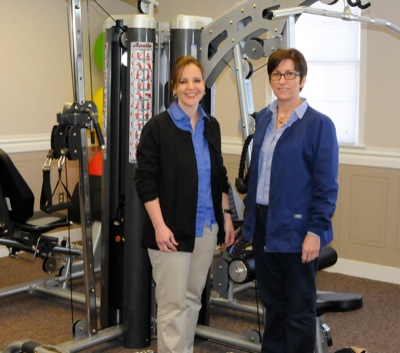Wednesday, March 12th, 2014
Sheriffs: Proposed jail changes may increase costs
By Kathy Thompson

Photo by Margie Wuebker/The Daily Standard
Corrections officer April Gerlach holds a tray of breakfast food this morning at the Mercer County Detention Center in Celina.
Area sheriffs say proposed new state standards could increase liability and costs at local jails.
The standards created by the Ohio Jail Advisory Board could be approved this month by the Joint Committee on Agency Rule Review for the approximately 340 county and city jails across the state, according to advisory board member Lt. Ryan Kidwell of the Hancock County Sheriff's Office.
The changes cover all jail operations and include guidance for how many meals inmates receive, the frequency of showers, the size of cells and how many correction officers should be on duty.
Mercer County Sheriff Jeff Grey and Auglaize County Sheriff Al Solomon believe the recommendations lower the standards they have in place and could further tighten their jail budgets.
If approved by the state review board, jail inspections would begin in July and focus on assessment and technical assistance, said JoEllen Smith, public information director for the Ohio Bureau of Corrections. Inspections next year would determine how jails have conformed to the new standards, she said.
Smith said the changes are centered on safety for inmates and staff.
"Efficiency and flexibility were predominant themes," she said. "Some media reports suggest the standards were lowered to reduce liability for jails and that is simply not true. We believe, by and large, the standards represent a raising of the bar."
No new jail recommendations have been approved since 2003; research by the Ohio Jail Advisory Board began in 2008. However, that board and the Bureau of Adult Detention disbanded in 2010 when the state ran into money issues, Kidwell said. The advisory board was brought back in 2012.
The state says the recommendations ensure inmates are being treated humanely and jails are not opening themselves up to litigation.
"We understand each jail is different," Kidwell said. "But we also know that jails need to follow standards. And we want those standards to be the best."
But Solomon believes lowering the standards could prompt civil liability for the county and his facility.
"This issue has been looked at several times by the state," he said. "We will have to see what actually comes out. We will not reduce our standards that we already have in place."
The new standards state a single cell should be 75 square feet. Grey said that's small; his cells are 90 square feet.
"Now, my lockdown cells are smaller," Grey said. "But inmates aren't kept there for long periods of time.
Grey said the size of the cell doesn't always matter; issues can still arise.
"You lock someone up in the same cell or room with the same person over a period of time, and someone is going to get on someone's nerves," he explained. "Here, we rotate inmates so that happens as little as possible. But remember, they are still in a cage. When you lock someone up in a room or a cell, don't let them come and go as they please, that's a cage. Even if you did that to the best of families, there's going to be an argument."
Solomon said the issue could spell trouble for older jails.
"How silly to ask a jail that is 30 years old to conform to these standards," he said. "It's like here. I just can't go to the voters and say, 'Hey, I need to build another wing because the state is telling me to.' I have to be responsible to the taxpayers of this county. When we built this jail 16 years ago, we tried to think of the future. Many of the older jails aren't going to be able to conform to what the state is asking."
The recommendations suggest separating inmates with mental health issues from the general population. Solomon said he agrees something needs to be done with inmates with those issues. His jail uses counselors.
"But this is a county corrections facility," Solomon said. "Not a hospital and not a mental health facility."
Staffing requirements would increase under the new standards, although an exact number has not been given.
The Mercer County jail employs 15 corrections officers, a chief deputy, a captain, a nurse and an administrative assistant.
"I have less employees in my jail than most," Grey said. "And I don't plan on adding more than I have to. My employees work hard."
The maximum number of inmates ever held at the Mercer County jail is 93. Grey said he averages 50 to 60 inmates per day.
The Mercer County jail has a budget of $1,322,000 per year.
"I'm not going to hire new corrections officers for 100 inmates when I don't have that many inmates daily," Grey said. "I may have that many in five or 10 years, but right now, we don't. Doing it right now would be a waste of taxpayer money."
Grey said he accepts inmates from other counties for a variety of reasons and would continue to do so. In 2012, those inmates brought in $106,000 to the county.
"But, again, we have to look at the numbers and see what this county needs and can do," Grey said.
The Auglaize County Detention Center budget is $1,165,460 and includes salaries for 31 employees, a full-time and part-time cook, a medical nurse, full-time corrections officers and a part-time correction officer. It has 72 beds for inmates and averages 55 to 65 inmates a day.
Solomon and Grey said they don't know exactly how the proposed standards will affect their budgets until the committee puts them in place.
"I think these standards need to be structured to meet all the county correctional facilities," Solomon said. "There needs to be further work done on this and we are the ones who operate or should operate the county correction facilities."
The proposed standards include reducing meals from three on weekends and holidays, down to two.
Kidwell said the calorie count for each inmate would remain the same with the meals being a little larger if only two were served on weekends. Each inmate, according to the state, is supposed to receive 2,800 to 2,900 calories a day.
Grey said his jail serves three meals a week and will continue to do so. The Auglaize County Detention Center also serves three meals a day.
"We've talked about cutting back to two," Grey said. "But problems in jails are sometimes generated because of food. Especially if an inmate has no money and can't buy anything from the commissary."
Grey has a kitchen at the jail and all meals are prepared on site each day by two cooks. Each meal averages about $1.94, and the menu, approved by a dietitian, changes daily for almost a month. It costs about $45 a day to house an inmate at the jail, Grey said.
"Most people don't eat three meals a day," Grey added. "But we're keeping it at that because it makes for a better climate."
Another new standard says each inmate shall be provided the opportunity for a hot shower every 48 hours.
Grey said shower accessibility is offered one hour in the morning and one hour in the evening. Water runs for 30 seconds at a time, Grey said.
"It means an inmate has to push a button several times during one shower, but the county is responsible for those water bills," Grey said.
The toilets are also controlled in the central control room.
Solomon said his jail allows inmates to shower at least once a day.
Kidwell said he and other board members realize all sheriff's or police chiefs in Ohio aredoing the "very best they can."
"We've made it so the standards are flexible enough to allow compliance," Kidwell said.
If a jail is found to be out of compliance, there could be consequences, Kidwell and Smith said.
Smith said the Ohio Revised Code provides a mechanism for enforcement and in a "worst case scenario," that enforcement would be used.
But Grey said he doesn't answer to a board.
"I answer to the voters of Mercer County," Grey said. "While I believe it's good to review the standards and ask the sheriffs what they thought, I'm not opposed to someone coming here and making recommendations. I am opposed to someone telling my bosses, the 41,000 voters, how to run their jail."



